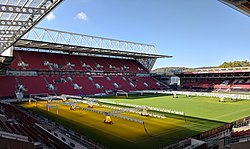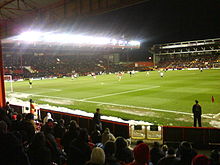Ashton Gate (stadium)
This article needs additional citations for verification. (July 2019) |
'The Gate' | |
 | |
 | |
| Full name | Ashton Gate Stadium |
|---|---|
| Location | Ashton Road, Bristol BS3 2EJ |
| Coordinates | 51°26′24″N 2°37′13″W / 51.44000°N 2.62028°W |
| Public transit | |
| Capacity | 26,462 |
| Record attendance | 43,335 (Bristol City F.C. vs Preston North End F.C., 16 February 1935) |
| Field size | 115 by 75 yards (105 m × 69 m) |
| Surface | Desso Grassmaster |
| Opened | 1887 |
| Tenants | |
| Bedminster F.C. (until 1900) Bristol City F.C. (1904–present) Bristol City W.F.C. (2023–present) Bristol Bears (2014–present) | |
Ashton Gate is a multi-use stadium in Ashton Gate, Bristol, England, and is the home of Bristol City F.C. and the Bristol Bears rugby union team. Located in the south-west of the city, just south of the River Avon, it currently has an all-seated capacity of 26,462 (usually advertised as 27,000).
History and arrangement
[edit]Ashton Gate was the home of Bedminster until their 1900 merger with Bristol South End who played at St John's Lane, and the merged club played at St John's Lane until the end of the 1903–04 season, when they moved to Ashton Gate.[1]

The ground has also played a part in the history of rugby in the city. Bristol played there on a number of occasions since the 1920s, one occasion being on 27 December 2006 when they defeated local rivals Bath Rugby 16–6 whilst selling out the stadium for an all-time record Premiership crowd outside of Twickenham. Several rugby internationals have been held, starting with England versus Wales in 1899. 100 years later, the All Blacks took on Tonga in a Rugby World Cup pool match. As of the 2014–2015 season, Bristol Rugby permanently moved to Ashton Gate.
It has hosted three England under-21 international friendlies. The first was against Italy on the 12th February 1997 with Darren Eadie scoring the winner in a 1–0 win in front of a crowd of 13,850.[2] The second was against Romania's under-21s on 21 August 2007. It ended in a 1–1 draw with Matt Derbyshire giving the hosts the lead on the eighth minute but Joe Hart's 25th minute own goal gifted the visitors a draw but they had Cristian Scutaru sent off on the seventy second minute for a second bookable offence. There were 18,640 in attendance. The third was against Uzbekistan's under-21s on 10 August 2010. The hosts beat the visitors 2–0 with Danny Rose scoring on the 64th minute and Martin Kelly scoring on the 78th minute. There were 9,821 in attendance. It also hosted the 2021 National League play-off final after it was moved from Wembley Stadium to avoid clashes with UEFA Euro 2020 matches.
After their promotion to the Women's Super League for the 2023–24 season it was announced that Bristol City Women would play all of their home games at Ashton Gate, having previously played the majority of their games at the club's High Performance Centre.[3]
Current stands
[edit]Lansdown Stand
Originally earmarked the "West Stand", this structure was completed in time for the start of the 2016–17 season and was immediately renamed The Lansdown Stand[4] in honour of the majority shareholder, Stephen Lansdown, who funded the Ashton Gate redevelopment. The stand marked the completion of the modern redevelopment of Ashton Gate. It is the largest in the stadium, with a capacity of 9,506. The stand has two tiers, accommodating 4,801 seats on the bottom and 4,371 seats on the top. The two levels are separated by a central area equipped with eighteen executive boxes. The roof is covered in solar panels to provide a renewable energy source to power the entire stadium. The Lansdown Stand houses the tunnel, team benches and TV gantry, whilst beneath the main seating areas are the changing rooms and offices. Three blocks of the upper tier of the Lansdown stand are designated as a family area for football matches, and one block of the lower tier is designated as the family area for rugby matches.
Dolman Stand
The Dolman Stand, which lies opposite the Lansdown Stand, was built in 1970, making it the oldest stand at Ashton Gate. At the time of construction it had a small, flat Family Enclosure in front of it, but during the close-season of 1996 this area which was built up and converted into seating. In the summer of 2007, following Bristol City's promotion to the Championship, the original wooden seats in the upper area were replaced by modern plastic seats. The stand is named after the former club chairman and president Harry Dolman. It was given a complete makeover during the summer of 2015 as part of the overall redevelopment of Ashton Gate. The current stand has a capacity of 6,675 seats (5,123 upper, 1,552 lower).
Atyeo Stand
The Atyeo stand is the smallest in the stadium with a capacity of 3,900. Originally holding around 4,200 spectators, it was built in 1994 to replace an open terrace and still contains the old dressing rooms and a large gymnasium. It is named after Bristol City legend John Atyeo, who played 645 times for City and scored 351 goals, making him the club's top goalscorer ever. He died in 1993, a year before the new stand opened. After the demolition of the Wedlock Stand, the north-east section of this stand was used to house the away fans. After construction of the Lansdown Stand, away fans were situated in the western three-quarters of the Atyeo stand. The whole stand was made available for away fans from the 2017/18 season onwards, reconfigured to hold 3,900 spectators. It is usually closed for rugby matches.

South Stand
Known as the first phase in the modern redevelopment of Ashton Gate, the South Stand was completed following the conclusion of the triumphant 2014–15 season. It has a capacity of 6,381, including 40 spaces and seats for wheelchair users and their assistants. It also includes a "singing section" for City's more vociferous fans, which is situated near the corner flag where the new stand meets the Dolman Stand at the south-east corner of the pitch. Unlike the other stands at Ashton Gate, it is not named after a person who had strong ties with the club. The stand is linked to its neighbouring Dolman and Lansdown stands via a concourse.
Former stands
[edit]Wedlock "East End" Stand

The old East End was demolished during the summer of 2014 and has been completely rebuilt to modern standards. It was built as a covered terrace in 1928, converted to seats in the 1990s and was the traditional home fans' end until 1994. It was known as the East End to City fans.
Williams Stand
The Williams Stand was on the southwest side, which included the directors' box and press box, and was built in 1958. The lower part of the stand was a terrace known as the Grand Enclosure until it was converted to seating in the 1990s. This stand was also named after a former chairman Des Williams. Demolition of this stand occurred in June 2015 in preparation for rebuilding to modern standards over the course of the next year.
Redevelopment of Ashton Gate
[edit]Following extensive planning and the failed bid to develop a new ground at Ashton Vale, and criticism of the failure of so many major leisure and sporting projects in Bristol,[5] Bristol City finally decided to press ahead with a major redevelopment of the current site at Ashton Gate.[6] This was approved in late 2013, with final clearance given in spring 2014, and work started in May 2014, following the final home fixture of the 2013–14 season.
The plans for redevelopment were as follows:
- Demolition of the existing Williams and Wedlock (East End) stands, to be replaced by new, larger stands, with executive boxes.
- Extension of the existing Dolman stand
- Shifting of the current pitch by 5 metres to enable the Dolman extension, and a new pitch laid to enable shared use with the rugby club
- Other works to the ground to bring it in line with modern stadia, with capacity of around 27,000
The works were completed prior to the start of the 2016–17 season.
Other uses
[edit]Rugby Union
[edit]Since August 2014 Ashton Gate has also been the home of Bristol Bears.
Ashton Gate has also held two international rugby union matches, as follows:
| Date | Competition | Home team | Away team | ||
|---|---|---|---|---|---|
| 18 January 1908 | 1908 Home Nations Championship | 18 | 28 | ||
| 3 October 1999 | 1999 Rugby World Cup, Pool 2 | 45 | 9 | ||
In September 2020, it was announced the stadium would host the 2019–20 Heineken Champions Cup final on 17 October,[7] the match was originally scheduled to be held in Marseille but was moved due to the COVID-19 pandemic.[8]
2025 Women's Rugby World Cup
[edit]In August 2023, the stadium was confirmed as one of eight host venues for the 2025 Women's Rugby World Cup.[9]
| Date | Country | Score | Country | Stage of Tournament | Attendance | Ref |
|---|---|---|---|---|---|---|
| 13 September 2025 | TBC | vs | TBC | Quarter-finals | ||
| 14 September 2025 | TBC | vs | TBC | Quarter-finals | ||
| 19 September 2025 | TBC | vs | TBC | Semi-finals | ||
| 20 September 2025 | TBC | vs | TBC | Semi-finals |
Rugby League
[edit]Ashton Gate has held one rugby league tour match,[10] as follows:
| Date | Competition | Home team | Away team | ||
|---|---|---|---|---|---|
| 20 December 1911 | 1911/12 Kangaroo Tour | Wales & West | 3 | 23 | |
Music
[edit]Ashton Gate has played host to concerts, including those of the Arctic Monkeys, The Who, The Rolling Stones, Westlife, Bryan Adams, Neil Diamond, Bon Jovi, The Best, Elton John[11] Meat Loaf, Muse, Spice Girls, Take That, The Killers, and Kings of Leon.
See also
[edit]References
[edit]- ^ Paul Smith & Shirley Smith (2005) The Ultimate Directory of English & Scottish Football League Grounds Second Edition 1888–2005, Yore Publications, p16, ISBN 0954783042
- ^ "England v Italy, 12 February 1997".
- ^ "Bristol City women can 'fill' Ashton Gate". BBC Sport. Retrieved 31 May 2023.
- ^ "New West Stand Named the Lansdown Stand | Bristol Sport". Archived from the original on 8 August 2016. Retrieved 6 August 2016.
- ^ "Why does Bristol never build anything?". BBC News. 16 January 2014.
- ^ "It's all kicking off as work starts on £40m makeover for Bristol City stadium". Bristol Post. 28 April 2014. Archived from the original on 11 October 2014. Retrieved 28 April 2014.
- ^ "Ashton Gate Stadium to host 2020 Heineken Champions Cup final". Bristol Sport. Retrieved 17 October 2020.
- ^ "Marseille finals moved to 2021 with new venues for this season to be decided". European Professional Club Rugby. 9 July 2020. Archived from the original on 9 August 2020. Retrieved 17 October 2020.
- ^ "Rugby World Cup 2025: Eight host venues named for tournament in England". BBC Sport. 21 August 2023. Retrieved 22 August 2023.
- ^ Shawn Dollin and Andrew Ferguson (1 February 2015). "Kangaroos Tour 1911/12". rugbyleagueproject.org.
- ^ "Sir Elton comes to Bristol". BBC. 10 December 2003. Retrieved 30 July 2012.
External links
[edit]- Bristol City F.C.
- Football venues in Bristol
- Rugby union stadiums in England
- Multi-purpose stadiums in the United Kingdom
- Rugby World Cup stadiums
- Music venues in Bristol
- English Football League venues
- American football venues in England
- 1887 establishments in England
- Sports venues completed in 1887
- 2025 Women's Rugby World Cup venues
